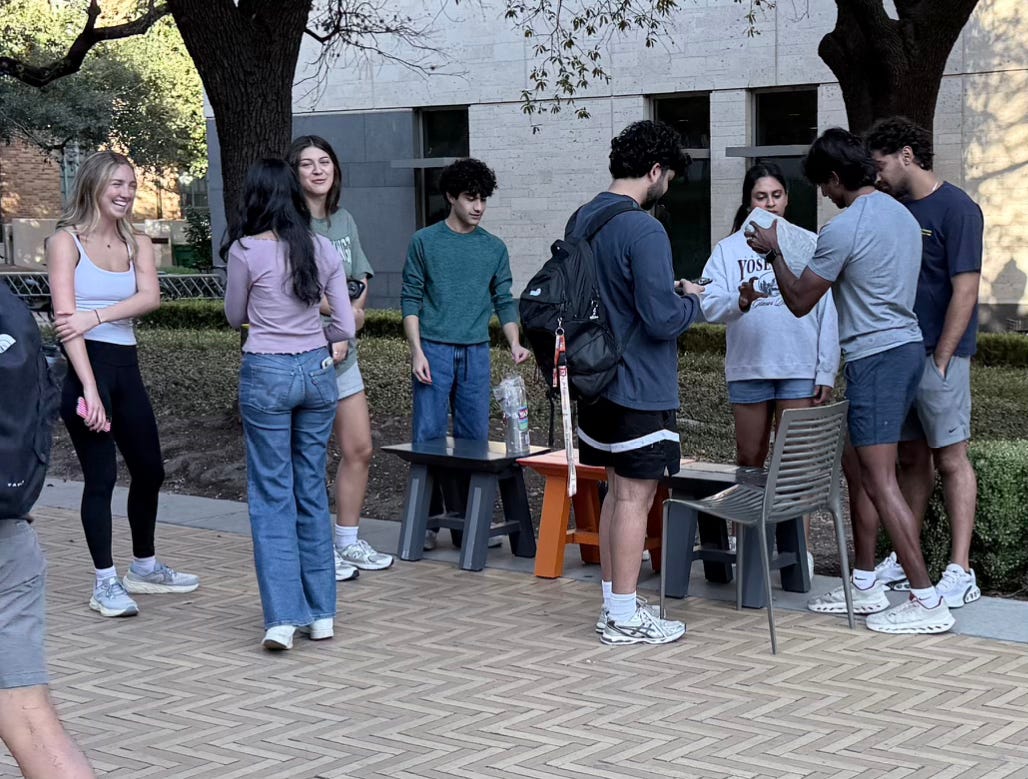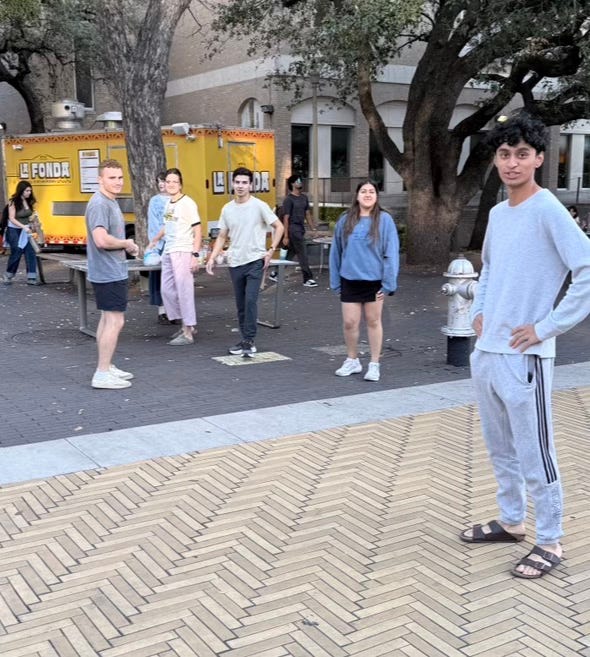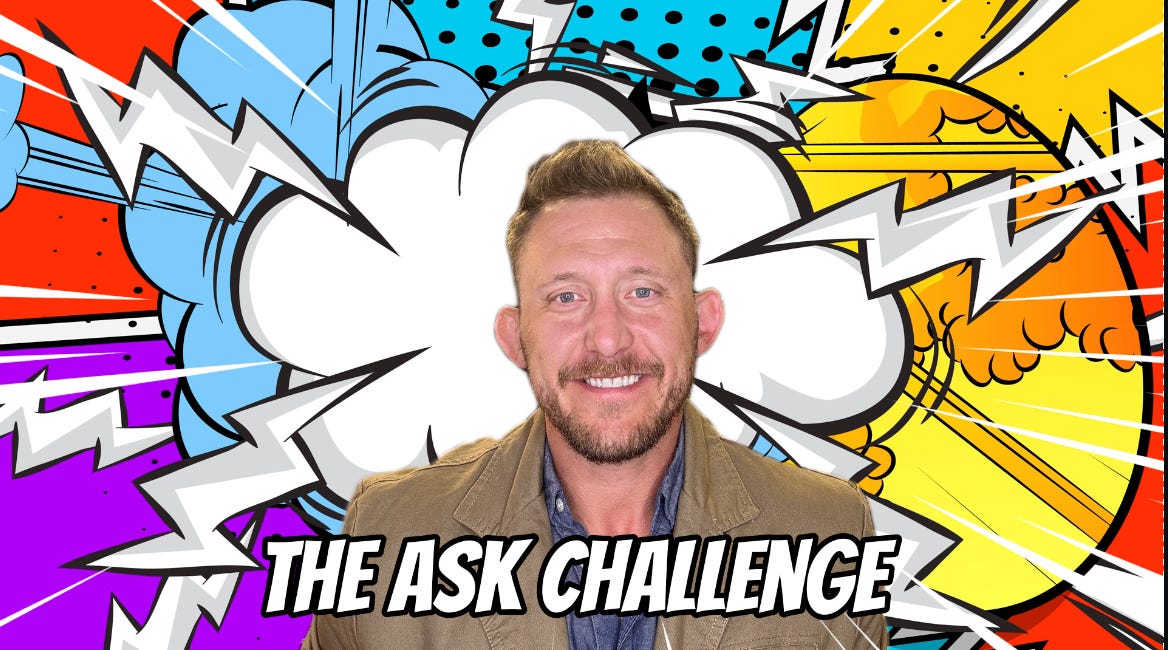The Ask Muscle
Entrepreneur is French for Salesman
Hey everyone. It has been a few weeks. I fell off the writing horse. Life got busy, a few big rocks shifted, and this newsletter slid into the back seat with my son’s baseball cleats. That happens. The important part is getting back to it, so here we are.
Quick life update. My son just wrapped his baseball season. They lost in the second round of the playoffs, but they finished as the top team in their division. Watching him get better each season has been a gift. I also took a step back from coaching this year. That was harder than I expected. I wanted to jump in, tweak his stance, fix his swing, offer one more tip. Instead, I tried to shut up and let other coaches work with him. His skills took a noticeable step up (I didn’t completely accomplish this but I’m human). Parenting lesson buried in there. At some point you have to trust other people with your kid’s development. Teachers, coaches, employers, mentors. You are not supposed to be every role forever. Letting go is good for them, and it is good for you.
The same idea has been playing out in my entrepreneurship class. For a few semesters I was guilty of the lazy professor move. Recycle last year’s slides. Tweak a date. Change one example. Call it a day. The feedback kept saying the same thing: less theory, more practical work. So this semester I finally listened. I rebuilt parts of the course around one core belief.
Entrepreneurship is mostly sales. I often joke that Entrepreneur is a french word for Salesman. You are always selling something. Your vision to early employees. Your product to customers. Your story to investors. Your sanity to yourself at 2 a.m. when everything is on fire. So I decided my job was not to give them a cute definition of sales. My job was to make them sell. This semester I stacked a series of “asks” that got progressively harder. Think of it as sales weight training.
Challenge 1: Ask for an interview
In teams, they had to leave the classroom and find a stranger to interview about problems or pains in their life. Zero pitch. Just questions. The point was not customer discovery slides. The point was to get used to walking up to a human and starting a conversation. If you cannot do that, you are not validating any idea. You are guessing in a spreadsheet. If you do not understand someone’s real pain, you cannot design the right solution, product, or MVP. This challenge is a softball, but it gets them used to asking for something valuable: someone’s time and attention.
Challenge 2: Ask for a discount
Next, they had to go to a coffee shop and ask for a discount. No coupon. No student deal. Just ask. This one feels cringe at first. People hate hearing “no,” and most of them have lived their whole life trying to avoid it. But what actually happens? Either you get the discount or you pay full price and drink your coffee. That is it. Some students came back with stories of free drinks or big discounts. Others got shut down. The real win was not the coffee. The win was rewiring how they think about rejection. Entrepreneurs hear “no” constantly. From investors, customers, partners, employees they want to hire. If “no” breaks you, the game will chew you up. You need reps.
Challenge 3: The Paperclip Game
Then we played the paperclip challenge. I hand them a paperclip and give them 20 minutes to trade up to something “bigger and better.”
Rules:
No trading personal items.
No trading with the same person twice.
No trading money.
No trading anything illegal.
The point is not the paperclip. The point is resourcefulness under constraint. Every semester a few students figure out they can borrow high-value items to use as trading chips: laptops, AirPods, even a Rolex once. That is exactly what you do in a real startup. You survive on borrowed resources: space, code, people, credibility. The students who see that pattern early tend to think like founders later.
Challenge 4: Ask for money
This is the one that matters. I split the class into 10-person teams, handed them lemonade or iced coffee, gave them cups, ice, and some markers, and told them they had 15 minutes to plan, 30 minutes to sell as much as possible.
They had to decide:
What is our price?
How do we package this?
Where do we stand?
What do we say?
They went out onto campus and got to work. In about half an hour, the class brought back roughly 400 dollars in revenue. About three times the cost of the supplies. The dread on their faces when I gave the assignment was replaced by big smiles, louder chatter, and that wired energy you only see when people realize, “Oh, we can actually do this.” More important than the money were the patterns that emerged.
Lesson 1: Pricing is not theoretical
On paper, pricing strategy sounds like a consulting slide. Penetration pricing, premium pricing, value-based pricing, and so on.
In the wild, it looked like this:
One team tried “free” with donations.
Another set a fixed price per cup.
Another adjusted price on the fly based on how people reacted.
Donation teams learned something fast. “Free” sounds too good to be true for a lot of people. If your sign says “free,” some people assume there is a catch and keep walking. When they reframed it as “donation based” and tied it to a cause, things picked up. Fixed price teams learned that most people do not blink at a clear, simple price. Two dollars. Three dollars. Done. But even they found customers who voluntarily paid more when they understood the challenge and wanted to help. The best groups did both. Clear anchor price, with permission for people to pay more if they wanted to support the class. Pricing is not a spreadsheet problem. It is a conversation with a human who has ten seconds before they cross the street.
Lesson 2: Location and traffic patterns matter more than your sign
The teams that camped out in areas with built-in foot traffic did better. Some went where student orgs were already tabling, others found spots near busy walkways. A few tried to stand in one place with a sign and wait for the world to come to them. That rarely works. You are one more piece of visual noise. People learn to tune you out. The strongest teams treated location as a variable, not a constraint. If a spot was dead, they moved. If people were rushing to class, they shifted to pre-poured cups and a faster pitch. They stopped worshiping their original plan and started following the data in front of their face. Entrepreneurship is iteration in real time.
Lesson 3: Your pitch is probably about you, not them
The first instinct for most students was “Lemonade?” or “Want to buy coffee?” That is not a pitch. That is a yes or no question with no context.
The better pitches gave people a reason to care:
“Hey, we are in an entrepreneurship challenge and trying to beat the other teams. Would you help us out and grab a lemonade?”
“It is for our class project. You will help us win, plus you look like you need caffeine.”
“We are donating the profits to [cause]. Want to support it?” (We are donating some of the money)
What changed? They stopped leading with the product and started leading with a story that invited participation. People do not buy lemonade. They buy a chance to help, to be part of something, to feel noticed. The lesson: Nobody is thirsty for your product. They are thirsty for a story that makes sense to them.
Lesson 4: Not all customers are equal
The teams quickly figured out that professors were gold. Professors understand assignments, love seeing students stretch themselves, and usually have cash handy. They also get pitched less often than undergrads on the speedway, so their “ignore” filter is lower. Some teams got real-time coaching from a professor who refused to buy until they tightened their story. They adjusted their pitch and immediately saw better results. They also learned that certain signals mean “do not bother.” Headphones in, fast walk, zero eye contact. That person is not your customer. Move on.
Great founders are great at selective effort. They know who to chase and who to let walk.
Lesson 5: Adaptation beats the perfect plan
Before they left the classroom, every team had a neat little plan. Pricing, location, roles. It all looked good on the whiteboard. Then they stepped outside and reality punched it in the mouth.
The quote I use from my Army days is, “No plan survives first contact.” The point of planning is not to follow it exactly. The point is to know what you are trying to achieve so you can adjust without losing the plot.
The best groups:
Changed prices in real time.
Swapped locations when a spot went cold.
Shifted from “stand and wait” to walking with customers.
Tightened their pitch after a few awkward reps.
The weaker groups clung to their original idea even when it was clearly not working. That is how startups die. Not from bad ideas, but from stubborn execution.
Lesson 6: Asking for money is a muscle
This is the part everyone tries to avoid, and the part that matters most. It is one thing to ask for an interview. People can be generous with time. It is another to ask for a discount. That feels edgy, but the downside is small. It is different when you look someone in the eye and say, “Will you give me your money?” Their money represents hours of their life at some job they may or may not enjoy. It is not just a transaction. It is value flowing from their effort to your idea. Most people feel a knot in their stomach when they ask. They talk too fast. They apologize. They discount before the customer even reacts.
By the end of this challenge, that knot was smaller. They had asked dozens of people for money, survived all the “no’s,” and realized they could do it again. That is the real assignment. Because here is the uncomfortable truth. If you do not get comfortable asking people for money, entrepreneurship is not your game. That does not mean you are a bad person. It means you should probably choose a role where someone else owns the ask.
But if you want to build something, you need this skill.
Why this matters beyond class
My son is getting better at baseball because I stepped back and let other coaches push him in ways I could not. My students are becoming real founders because I stopped lecturing about customer discovery and made them talk to strangers, negotiate discounts, and sell products in the wild.
And all of us, myself included, need regular reps asking for things that matter. Time. Help. Feedback. Promotions.
Here is what all of this builds:
Talk to people instead of guessing.
Ask for what you want without apologizing for it.
Adapt to reality faster than your competition.
So if you want a small challenge for yourself this week, try this:
Ask for something that makes you a little uncomfortable. A discount. A warm intro. A pilot customer. An upgrade. Do it on purpose. Notice that you did not die. Then do it again.
Entrepreneur is not actually the French word for salesperson. But it might as well be.
Connect with Zach
Provide Feedback
Related Articles:
Courage When It Counts
Hey Everyone, I’m back after an unplanned two-week break. No big crisis, just a creative lull. I’ve always believed if you have nothing worth saying, it’s fine to say nothing. But I’d like to get back to a weekly rhythm. Oliver Burkeman, one of my favorite writers, only posts,
The Paperclip Hustle
Every semester, my favorite class activity is the Bigger, Better Challenge. I split my students into pairs and give each team one item: a paperclip. Their mission? Trade up for something bigger, better, and more valuable (in my opinion). The constraints? They have
The Ask Challenge
Last weekend, Jackie and I celebrated our 14th anniversary, and it was an absolute blast.









